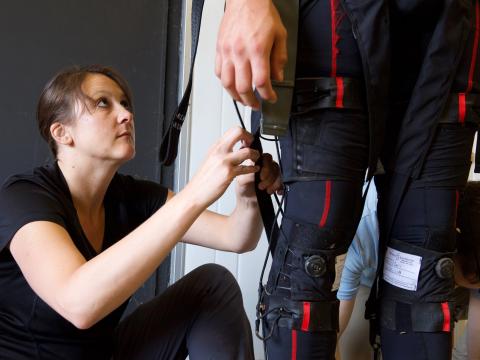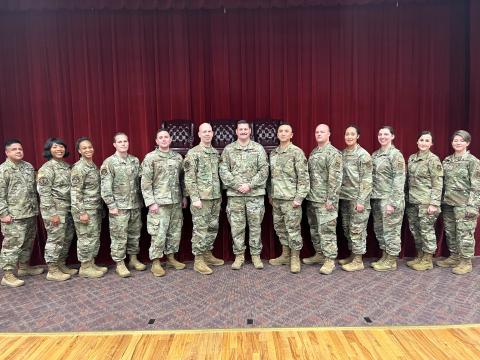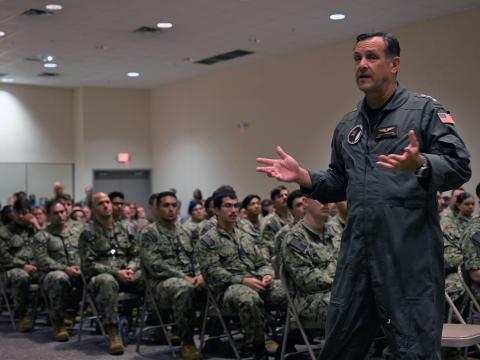Video Streams to The Tip of The Spear
The Remote Operations Video Enhanced Receiver (ROVER) 5 handheld unit allows troops to access video imagery directly from airborne reconnaissance platforms. Developed by L-3 Communications, the ROVER 5 also enables soldiers to mark targets on a digital map display or video image and transmit the data back to pilots overhead.
Handheld monitors allow ground troops to view reconnaissance data in real time. 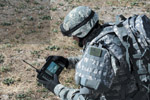
Dismounted warfighters soon will have access to live imagery transmitted from aerial sensor platforms. This mobile video capability allows infantry and special operations units to capture and share video streams across tactical communications and data networks. The equipment consists of two new lightweight systems that move what had originally been a command post and vehicle-based system to the company and squad level.
The two systems are the ROVER 5 Handheld, manufactured by L-3 Communications, New York City, and the AN/PRC-117G manpack radio, made by Harris RF Communications, Rochester, New York. Both systems use the Remote Operations Video Enhanced Receiver (ROVER) technology that allows unmanned aerial vehicles (UAVs) and manned platforms to beam live video feeds down to ground forces.
Designed to fit in a soldier’s cargo pocket, the ROVER 5 handheld receiver builds on L-3’s experience in designing and manufacturing the ROVER III and ROVER 4 systems for use in vehicles and command posts. Evan Deneris, L-3’s director of advanced product development,
The other ROVER versions use a laptop computer or any other type of monitor that can plug into the unit to display video imagery. ROVER 5 features a small built-in monitor, but external laptops, monitors and antennas can plug into the unit. The shape of the device, which resembles a handheld gaming console, evolved over a year and a half as user feedback optimized the screen size and the layout.
Another customer request was the ability to both transmit and receive data. The previous ROVER versions only receive imagery, Deneris says. ROVER 5 can piggyback on the signals of other ROVER versions. It also can be used as a stationary system containing all the capabilities of its predecessors. The transmission capability enables users on the ground to indicate or mark a target on a digital map or video signal and send the data to an aircraft. This ability eliminates the ambiguity and difficulty a pilot encounters when trying to identify what a forward air controller on the ground sees. A digital camera can be hooked up to the device to send soldier’s-eye views to an aircraft. ROVER 5 units can also transmit data to each other, but they must be within line of sight or in very close proximity, he says.
ROVER 5 includes an additional ultrahigh frequency (UHF) band to operate with other platforms. L-3 engineers used commercial touch-screen technology, available video compression and gate arrays for the device’s internal software-defined radio.
Antennas are built into the top of the ROVER 5 unit. Four small surface flap antennas are available for the high frequency S, L, C and Ku bands. A short external antenna can be attached to the device for UHF signals. The antennas receive in a hemispherical pattern. Deneris notes that the device features a signal strength indicator. Evaluations are underway to determine if operators must position themselves toward the aircraft to maintain connectivity. He adds, however, that users typically know their relation to an overhead aircraft by the tracking data in their equipment.
ROVER 5 is now in its pre-production phase with test versions issued to customers for evaluation. Initial production orders numbering in the hundreds will be delivered in June or July. Deneris notes that L-3 has several orders for large numbers of ROVER 4 units. These customers have shown interest in switching their orders partially or entirely to ROVER 5s.
Harris Corporation ported the ROVER waveform into its AN/PRC-117G manpack radio. When combined with a monitor, the radio allows troops to perform a variety of operations, such as receiving video streams and conducting voice and data communications. Overhead video imagery also can be streamed live to other AN/PRC-117G radios in a tactical network.
Unlike the L-3 version, Harris’ ROVER capability is built almost entirely on software. The company ported the ROVER waveform into its Falcon III AN/PRC-117G wideband manpack radio. Steve Marschilok, vice president and general manager of Harris’s Defense Department business unit, notes that the radio’s broadband capability and Joint Tactical Radio System (JTRS)-compatible waveform allow it to host and provide a variety of applications. 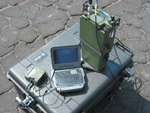
Harris’ ROVER capability began in 2007 when a customer asked if the AN/PRC-117G could support the waveforms for ROVER video streams, says Mark Benoit, Harris RF’s account manager for Defense Department sales. Because the software-defined radio uses the open-software communications architecture (SCA), insertion of the waveform into the radio was relatively easy. Adding the capability to an existing multifunction radio provides warfighters with more operational flexibility than a vehicle-based or stationary system, he says.
Marschilok maintains that the AN/PRC-117G meets JTRS program goals because the SCA and its software-based capability allow new waveforms to be ported into the radio. In the case of the AN/PRC-117G, the software-based architecture increases the radio’s multimode, multiband capabilities, he says. The software-defined system provides warfighters with a lightweight capability in a single piece of equipment. The original vehicle-based ROVER III unit can weigh up to 50 pounds. Although the system is described as man-portable, the weight of batteries, antennas and ancillary equipment restricts it primarily to vehicular use. The 12-pound AN/PRC-117G allows units to carry the system on dismounted operations, Benoit says.
The Harris system consists of the radio, an antenna and a display device. Operating in ROVER mode, the AN/PRC-117G can use any type of input/output display device such as ruggedized laptop computers and personal digital assistants. As a primarily software-based system, one of the few equipment considerations is selecting the right antenna for the waveform, says Marschilok. ROVER functions are accessed via a browser loaded onto the handheld input/monitor device plugged into the radio. Connectivity is managed via an Ethernet network that transmits data in a streaming format.
The first iteration of the ROVER capability operates in the L band. Benoit explains that the majority of small UAVs use this band as their operating frequency. But he adds that additional bands will be added to meet new capabilities, and more antennas will be developed to support those bands.
The predecessor of the AN/PRC-117G, the AN/PRC-117F, combined a number of different radios into a single form factor. However, the AN/PRC-117G has the advantage of an extended frequency band of 512 megahertz to 2 gigahertz. Marschilok says that the ROVER capability is a useful application in this bandwidth range.
Because UAV/ROVER applications are becoming ubiquitous, integrating the function into a standard radio provides this capability to the user base, claims Marschilok. “Today, a ROVER terminal would be centrally located because of its size and cost. Information gained on that terminal would somehow have to be distributed to other users in the area. By putting the capability in the multimode radio that the users have, everybody in the area can have it,” he says.
ROVER video data distributed to tactical users will allow units to acquire live video of enemy movements, such as on rooftops or on the other side of a hill in their operational area. Marschilok notes that many of the uses for the system are still unknown. “All of this is so new. Between the extended frequency band, the extended bandwidth and the small compact size and weight, these are considerations that users have never been able to think about before,” he says.
Another potential application is receiving input from ground-based robots. Benoit notes that the majority of ground-based robots transmit in the L band. “Today, with a UGV [unmanned ground vehicle], there is a single operator, and he’s the only one who sees the imagery. Now the guy around the corner who is closest to the threat can pull the video feed and use the intelligence. Now you’re much closer to the tip of the spear with your solution,” explains Benoit, adding that video data typically is relayed from a command post to forward units.
Video data also can be transmitted on Harris’ ANW2 commercial wideband networking waveform. One potential use of the capability would be to stream live video from helmet-mounted cameras back to an operations center. This data could be streamed simultaneously from an AN/PRC-117G while the radio is also supporting voice communications.
Another application allows UAV video downlink feeds to be transmitted across a tactical network with voice and data communications. Because it is Type 1 encrypted, data from an AN/PRC-117G can be linked to the secret Internet protocol router network and connected to theater headquarters. The AN/PRC-117G ROVER capability will begin to deploy to operational units this spring.
Web Resources
L-3 Communications: www.l-3com.com
Harris Corporation: www.harris.com
